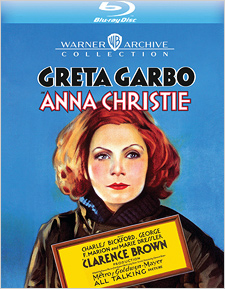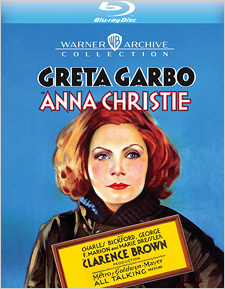Anna Christie (Blu-ray Review)

Director
Clarence Brown, Jacques FeyderRelease Date(s)
1930 (December 12, 2023)Studio(s)
Metro-Goldwyn-Mayer (Warner Archive Collection)- Film/Program Grade: B+
- Video Grade: B+
- Audio Grade: C
- Extras Grade: B
Review
Certain classical Hollywood movies like Casablanca, Singin’ in the Rain, and The Wizard of Oz are basically audience-proof, i.e., one could show them to younger folk leery of anything more than 10 years old, and they’d probably love it. At the other end of the spectrum are pictures like Anna Christie (1930), a movie acclaimed and popular when it was new but which today is unlikely to appeal to anyone other than hard-core movie buffs.
The film stars Greta Garbo in her first talking picture. At MGM she became one of their biggest stars of the late (1926-29) silent era, but everyone there was worried about her husky Swedish accent. Would it play or be laughed off the screen? The studio delayed her talkie debut, Garbo making her last (and MGM’s last) silent film, The Kiss, in 1929. By 1930, delay the inevitable no longer. Ads for the greatly anticipated Anna Christie promised, “Garbo Talks!” (Also, incidentally, Garbo Laughs in Anna Christie, long before Ninotchka.)
As was common if short-lived during the early talkie-period, a foreign language version of Anna Christie was shot simultaneously, Garbo also starring in MGM’s German-language version, which otherwise features a native German-speaking cast but the same sets and (mostly) the same costumes. That version is credited to Jacques Feyder, director of The Kiss, though some sources suggest most of it was actually helmed by Edgar G. Ulmer. The Belgian Feyder worked primarily in France before coming to Hollywood while Ulmer worked extensively in Germany during the silent period, so who knows?
The film is based on Eugene O’Neill’s 1921 play, previously filmed in 1923. The opening scenes, set in a fog-shrouded New York harbor area at night, are striking for their similarity to Gregg Toland’s later, celebrated cinematography of John Ford’s The Long Voyage Home, also based on O’Neill. However, Anna Christie mostly suffers from the same problems as other early talkies—it’s exasperatingly static and stagey. Most of its 89-minute running time takes place, as in the original play, on just two sets.
Fifteen years after abandoning his daughter to relatives in Minnesota, Chris Christofferson (George F Marion), the alcoholic skipper of a coal barge, learns that his daughter, Anna “Christie” Chistofferson (Garbo), is leaving Minnesota to come and stay with him. He imagines that she’s developed into some sort of refined beauty, unaware that she faced years of abuse, including rape, by family members back on the farm and for the last several years the heavy-drinking Anna has been working in a brothel. Nonetheless, when they reunite, lonely Chris urges Anna to live with him on his barge.
Anna gradually recovers aboard Chris’s boat but then they rescue sailor Matt (Charles Bickford), lost at sea for five days. Anna and Matt fall in love and spend all their free time together. (Included is some interesting footage in both versions of Garbo riding a roller coaster.) A chance encounter with broken-down tart Marthy Owens (Marie Dressler), Chris’s one-time lover, reminds Anna of her own dark past, and she refuses Matt’s proposal of marriage. Meanwhile, Chris becomes jealous of Anna spending all her time with Matt and the possibly he make take her away from him.
Warner Archive’s new Blu-ray offers both the English and German versions. I ended up watching the first 20 minutes of the English version, switched over to the German version for the rest of the film, then went back and looked at selected scenes from the English version I had missed.
One reason I did that is because Garbo herself much preferred her performance in the German version. Possibly at that point Garbo’s German was better than her English, but one can also see a much more naturalistic performance in the German version, whereas director Clarence Brown, or maybe studio edict, imposed more “exotic,” Hollywood star-style vamping. Indeed, by 1930 Garbo had lost so much of her Swedish accent she reportedly was directed to speak with a thicker accent in the English version, to maintain that “Garbo mystique,” I guess. In both languages, however, Garbo delivers performances generally far superior to most leading actresses in dramatic films at the time. By this point she knew how to underplay to the camera and express deep emotions without relying on the kind of flowery dialogue one often finds in these earliest talkies.
Another reason I switched to the German version was the supporting cast. George F. Marion, reprising his performance from both the stage and 1921 film versions, is fine as Anna’s father, but Marie Dressler is perfectly dreadful as the boozy, washed-up tramp. A comic star of the stage and silent comedies, she seems to playing to those audiences with a rubber-faced drunk performance worthy of Clyde the Orangutan in Every Which Way but Loose. (Ironically, Dressler, much better in subsequent films, became an even bigger star than Garbo, indeed the top box-office draw in the country for several years until her death in 1934.) In her early ‘60s but looking at least ten years older, here Dressler plays a part that seems written for a younger woman, say about 40. Certainly, one can only shudder imagining Marthy soliciting at her age and physical condition. The German version casts Garbo’s close friend Salka Viertel as Marthy; Viertel, later co-wrote many Garbo scripts. She was 41. Likewise, 39-year-old Charles Bickford is just a tad too old for the part. Even then he was more of a character actor type, and hardly the strapping sailor one would expect Garbo to fall for. Theo Shall in the German cut was only five years younger, but he’s much better physically and a good actor besides.
Warner Archive’s Blu-ray of Anna Christie looks just okay; one has come to expect stunning transfers on every Warner Archive release, I suppose. The early reels of the English version seem rather soft to my eyes, as if from secondary film elements, though later reels are notably improved. The German version looks better than the first reel or two of the English source, but not as good as the later ones. The German version also has much weaker audio (both are DTS-HD Master Audio mono), which is scratchy throughout: was MGM still using sound-on-discs in 1930? The English subtitles on the German version are good but formatted strangely, at least on my Sony player and projection system, which tended to left-indent the subtitles partially outside the frame area.
Besides the German version, supplements consist of a 1938 Lux Radio Theater adaptation of Anna Christie with Joan Crawford in the title role; a 1956 episode of the misbegotten M-G-M Parade television series, here hosted by Walter Pidgeon who runs a “best of” salute to Garbo with clips from her movies; and the 1930 Looney Tunes cartoon (in black-and-white) The Booze Hangs High, co-animated by Friz Freleng and shamelessly imitative of Walt Disney’s crude barnyard cartoons from the same period.
Classical Hollywood completists will want to see Anna Christie once, but it’s definitely not the type of film you’ll likely want to watch over-and-over. Recommended.
- Stuart Galbraith IV

